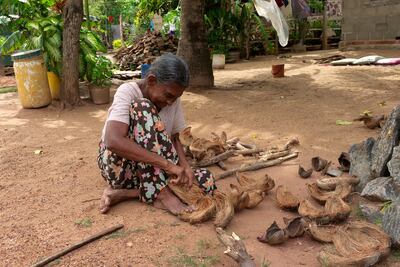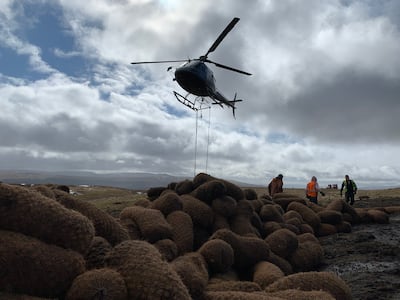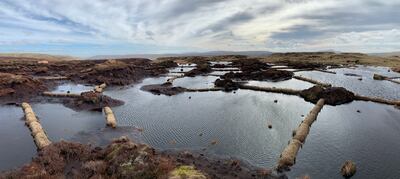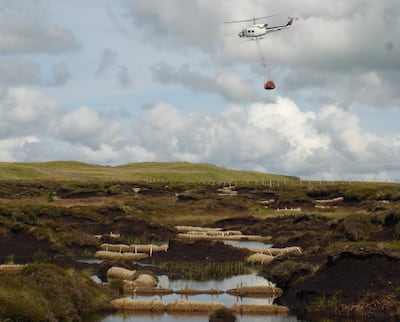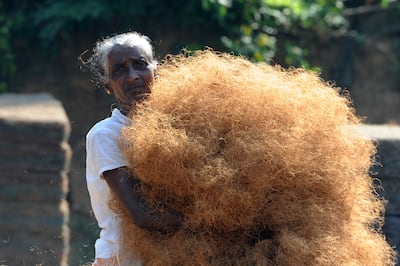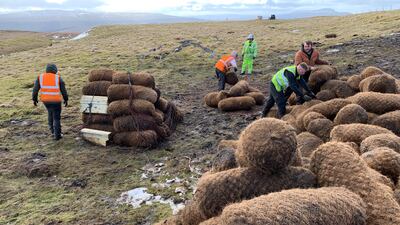When climate change threatened to destroy one of Britain’s beauty spots few people would have thought that coconuts from Sri Lanka would be its salvation.
But 9,000 kilometres away, in sun-drenched surroundings, an army of women are helping to save the planet through the use of coconuts.
Using coir, the coarse fibre extracted from coconut husk, the women hand weave it to create nets and logs which are now being used to protect the UK’s peatland by preventing huge amounts of carbon from being released into the atmosphere.
Three years ago the Yorkshire Dales peatland, which stores 38 million tonnes of carbon, reached crisis point as waters running off the hills started destroying vast quantities of peat.
That has led to polluting sediment entering the UK’s rivers, costing millions to clean, and critically the release of carbon from the damaged peat bogs.
With the UK containing 13 per cent of the world’s blanket bog, experts said urgent action was needed to combat its decay.
“Peat is essentially dead plants that have not decomposed fully,” Lyndon Marquis of the Yorkshire Peatland Partnership told The National.
“Because they have not broken down, the carbon from those once-living plants is trapped in the peat — we estimate that Yorkshire’s peatland stores 38 million tonnes of carbon.
“Bare, damaged peat is vulnerable to erosion by wind and rain. It’s vital that we restore our degraded peatland to keep that carbon locked up in the ground.”
Peatland acts as a huge carbon store and, when healthy, is able to absorb carbon from the atmosphere, locking it away for thousands of years.
But damaged or degraded peatland actively leaks carbon, contributing to climate change.
It takes 1,000 years for a metre of peat to form and in one area of the Yorkshire Dales, at Fleet Moss, near Hawes, channels over 4m deep have appeared.
More than a quarter of England’s peat bogs are in Yorkshire. The Yorkshire Peatland Partnership estimates there are about 94,760 hectares of blanket bog in the region and that 80 per cent of it has been damaged.
Now helicopters are dropping coir logs on to the parkland in the ravaged areas.
The logs are then dug into the ground, providing a barrier to the water coming down off the hills and slowing the flow. The peat sediment is trapped, allowing vegetation to return.
'Unforgiving' weather creates microclimate over the peatland
When The National visited the peatland to see the restoration work first-hand, the damage across the moorlands was apparent, with gaping gullies that had once trapped vital carbon.
High up on a remote hillside, the rangers warned that every day the climate surrounding the peatland was “unforgiving” and from leaving a sultry summer's day a few miles away, the temperature can plummet to 3°C, with violent wind and rain.
Despite the damage being done by the continuous wild weather, the coir logs are helping.
And, reassuringly, the effectiveness of the coir was visible, with sediment being prevented from moving and vital vegetation returning.
“The coir is vital in helping to protect the area,” Mr Marquis said.
“The water from here travels off the hills and leads to flooding more than 100km away in places such as York.
“In its current state, water runs off very quickly, especially during heavy rainfall events, which can lead to flooding further down the catchments. By restoring the peatland here, we can help to hold water on the hills for longer, mitigating flooding for communities downstream.”
For the rangers, the work to protect the peatland is a mammoth task and every day workers are on site repairing the damage.
“The weather here is unforgiving and we have people on site every day of the year working to stem the water to protect the peatland,” Mr Marquis said.
One of those tasked with its protection is Jenny Sharman, a Peatland Restoration Officer at the Yorkshire Peatland Partnership.
It is her job to decide where the coir logs are placed and she has seen their effectiveness.
“I am blown away by the effectiveness of coir. We see the results almost immediately. It is very gratifying to see,” she told The National.
“We use it quite substantially across all our sites now. We started in 2018 and since then we have got quite a lot of experience of what works best.
“The flowing water destroys everything in its path. It is so important to have this because there is a massive amount of sediment washed down into the rivers from the peatland sites and it costs millions to clean the water.
“It has a huge impact on society. As soon as the peat erodes vast amounts of carbon goes into the atmosphere and creates climate change. This work is vital to protecting the environment.”
The amount of carbon that currently comes off eroded peatland is estimated at 10 million tonnes per year in the UK.
UK firm Salix imports hundreds of tonnes of compressed coir fibre from Sri Lanka every year and makes it into logs at its centre in Norfolk.
“Coir was originally used on river beds to stop erosion of the banks and we have adapted it to suit peatland restoration,” Ms Sharman said.
“We work with Salix to develop the logs to our classification to be used on the site.
“It's amazing to think that there is an army of women in Sri Lanka gathering the coir and they are even using it to hand weave the sacks the coir goes into. Their work is beautiful.
“The work they are doing is helping us to save Yorkshire and is also having an impact on global climate change.”
In Sri Lanka, the Nagenahiru Foundation, a non-profit community organisation, has been training women in deprived areas to make products from coir.
Sri Lanka's coir now accounts for 16 per cent of the world’s total coir production and represents 40 per cent of the country’s exports.
Salix began working with one village after it was virtually wiped out during the 2004 tsunami and now supports hundreds of residents.
“We have developed a close relationship with a particular village in Sri Lanka, helping to support the local community and enabling us to sustainably import large quantities of high quality coir fibre,” said David Holland, Salix's technical director.
“The village was virtually wiped out during the 2004 tsunami and the local people are still rebuilding their community.
“Salix’s coir business supports the entire village of 400 people and allows higher than average earnings for those employed in the fibre processing.
“We are also proud to support the village by buying their hand-spun coir erosion control netting.”
Its coir comes from organically managed plantations and excess coir husk is returned to the soil as a natural fertiliser.
“It really is a true international effort to keep our peatland safe for the future,” Ms Sharman said.
UAE currency: the story behind the money in your pockets
10 tips for entry-level job seekers
- Have an up-to-date, professional LinkedIn profile. If you don’t have a LinkedIn account, set one up today. Avoid poor-quality profile pictures with distracting backgrounds. Include a professional summary and begin to grow your network.
- Keep track of the job trends in your sector through the news. Apply for job alerts at your dream organisations and the types of jobs you want – LinkedIn uses AI to share similar relevant jobs based on your selections.
- Double check that you’ve highlighted relevant skills on your resume and LinkedIn profile.
- For most entry-level jobs, your resume will first be filtered by an applicant tracking system for keywords. Look closely at the description of the job you are applying for and mirror the language as much as possible (while being honest and accurate about your skills and experience).
- Keep your CV professional and in a simple format – make sure you tailor your cover letter and application to the company and role.
- Go online and look for details on job specifications for your target position. Make a list of skills required and set yourself some learning goals to tick off all the necessary skills one by one.
- Don’t be afraid to reach outside your immediate friends and family to other acquaintances and let them know you are looking for new opportunities.
- Make sure you’ve set your LinkedIn profile to signal that you are “open to opportunities”. Also be sure to use LinkedIn to search for people who are still actively hiring by searching for those that have the headline “I’m hiring” or “We’re hiring” in their profile.
- Prepare for online interviews using mock interview tools. Even before landing interviews, it can be useful to start practising.
- Be professional and patient. Always be professional with whoever you are interacting with throughout your search process, this will be remembered. You need to be patient, dedicated and not give up on your search. Candidates need to make sure they are following up appropriately for roles they have applied.
Arda Atalay, head of Mena private sector at LinkedIn Talent Solutions, Rudy Bier, managing partner of Kinetic Business Solutions and Ben Kinerman Daltrey, co-founder of KinFitz
Tips for avoiding trouble online
- Do not post incorrect information and beware of fake news
- Do not publish or repost racist or hate speech, yours or anyone else’s
- Do not incite violence and be careful how to phrase what you want to say
- Do not defame anyone. Have a difference of opinion with someone? Don’t attack them on social media
- Do not forget your children and monitor their online activities
%3Cp%3E%3Ca%20href%3D%22https%3A%2F%2Fwww.thenationalnews.com%2Fbusiness%2Feconomy%2Fislamic-economy-consumer-spending-to-increase-45-to-3-2tn-by-2024-1.936583%22%20target%3D%22_self%22%3EGlobal%20Islamic%20economy%20to%20grow%203.1%25%20to%20touch%20%242.4%20trillion%20by%202024%3C%2Fa%3E%26nbsp%3B%3C%2Fp%3E%0A%3Cp%3E%3Ca%20href%3D%22https%3A%2F%2Fwww.thenationalnews.com%2Fbusiness%2Feconomy%2Fuk-economy-plunges-into-worst-ever-recession-after-record-20-4-contraction-1.1062560%22%20target%3D%22_self%22%3EUK%20economy%20plunges%20into%20worst-ever%20recession%20after%20record%2020.4%25%20contraction%3C%2Fa%3E%3C%2Fp%3E%0A%3Cp%3E%3Ca%20href%3D%22https%3A%2F%2Fwww.thenationalnews.com%2Fbusiness%2Feconomy%2Fislamic-economy-consumer-spending-to-increase-45-to-3-2tn-by-2024-1.936583%22%20target%3D%22_self%22%3EIslamic%20economy%20consumer%20spending%20to%20increase%2045%25%20to%20%243.2tn%20by%202024%3C%2Fa%3E%3C%2Fp%3E%0A
Juvenile arthritis
Along with doctors, families and teachers can help pick up cases of arthritis in children.
Most types of childhood arthritis are known as juvenile idiopathic arthritis. JIA causes pain and inflammation in one or more joints for at least six weeks.
Dr Betina Rogalski said "The younger the child the more difficult it into pick up the symptoms. If the child is small, it may just be a bit grumpy or pull its leg a way or not feel like walking,” she said.
According to The National Institute of Arthritis and Musculoskeletal and Skin Diseases in US, the most common symptoms of juvenile arthritis are joint swelling, pain, and stiffness that doesn’t go away. Usually it affects the knees, hands, and feet, and it’s worse in the morning or after a nap.
Limping in the morning because of a stiff knee, excessive clumsiness, having a high fever and skin rash are other symptoms. Children may also have swelling in lymph nodes in the neck and other parts of the body.
Arthritis in children can cause eye inflammation and growth problems and can cause bones and joints to grow unevenly.
In the UK, about 15,000 children and young people are affected by arthritis.
GAC GS8 Specs
Engine: 2.0-litre 4cyl turbo
Power: 248hp at 5,200rpm
Torque: 400Nm at 1,750-4,000rpm
Transmission: 8-speed auto
Fuel consumption: 9.1L/100km
On sale: Now
Price: From Dh149,900
Important questions to consider
1. Where on the plane does my pet travel?
There are different types of travel available for pets:
- Manifest cargo
- Excess luggage in the hold
- Excess luggage in the cabin
Each option is safe. The feasibility of each option is based on the size and breed of your pet, the airline they are traveling on and country they are travelling to.
2. What is the difference between my pet traveling as manifest cargo or as excess luggage?
If traveling as manifest cargo, your pet is traveling in the front hold of the plane and can travel with or without you being on the same plane. The cost of your pets travel is based on volumetric weight, in other words, the size of their travel crate.
If traveling as excess luggage, your pet will be in the rear hold of the plane and must be traveling under the ticket of a human passenger. The cost of your pets travel is based on the actual (combined) weight of your pet in their crate.
3. What happens when my pet arrives in the country they are traveling to?
As soon as the flight arrives, your pet will be taken from the plane straight to the airport terminal.
If your pet is traveling as excess luggage, they will taken to the oversized luggage area in the arrival hall. Once you clear passport control, you will be able to collect them at the same time as your normal luggage. As you exit the airport via the ‘something to declare’ customs channel you will be asked to present your pets travel paperwork to the customs official and / or the vet on duty.
If your pet is traveling as manifest cargo, they will be taken to the Animal Reception Centre. There, their documentation will be reviewed by the staff of the ARC to ensure all is in order. At the same time, relevant customs formalities will be completed by staff based at the arriving airport.
4. How long does the travel paperwork and other travel preparations take?
This depends entirely on the location that your pet is traveling to. Your pet relocation compnay will provide you with an accurate timeline of how long the relevant preparations will take and at what point in the process the various steps must be taken.
In some cases they can get your pet ‘travel ready’ in a few days. In others it can be up to six months or more.
5. What vaccinations does my pet need to travel?
Regardless of where your pet is traveling, they will need certain vaccinations. The exact vaccinations they need are entirely dependent on the location they are traveling to. The one vaccination that is mandatory for every country your pet may travel to is a rabies vaccination.
Other vaccinations may also be necessary. These will be advised to you as relevant. In every situation, it is essential to keep your vaccinations current and to not miss a due date, even by one day. To do so could severely hinder your pets travel plans.
Source: Pawsome Pets UAE
if you go
More on Quran memorisation:
RESULTS
Catchweight 63.5kg: Shakriyor Juraev (UZB) beat Bahez Khoshnaw (IRQ). Round 3 TKO (body kick)
Lightweight: Nart Abida (JOR) beat Moussa Salih (MAR). Round 1 by rear naked choke
Catchweight 79kg: Laid Zerhouni (ALG) beat Ahmed Saeb (IRQ). Round 1 TKO (punches)
Catchweight 58kg: Omar Al Hussaini (UAE) beat Mohamed Sahabdeen (SLA) Round 1 rear naked choke
Flyweight: Lina Fayyad (JOR) beat Sophia Haddouche (ALG) Round 2 TKO (ground and pound)
Catchweight 80kg: Badreddine Diani (MAR) beat Sofiane Aïssaoui (ALG) Round 2 TKO
Flyweight: Sabriye Sengul (TUR) beat Mona Ftouhi (TUN). Unanimous decision
Middleweight: Kher Khalifa Eshoushan (LIB) beat Essa Basem (JOR). Round 1 rear naked choke
Heavyweight: Mohamed Jumaa (SUD) beat Hassen Rahat (MAR). Round 1 TKO (ground and pound)
Lightweight: Abdullah Mohammad Ali Musalim (UAE beat Omar Emad (EGY). Round 1 triangle choke
Catchweight 62kg: Ali Taleb (IRQ) beat Mohamed El Mesbahi (MAR). Round 2 KO
Catchweight 88kg: Mohamad Osseili (LEB) beat Samir Zaidi (COM). Unanimous decision
RESULTS
Bantamweight: Victor Nunes (BRA) beat Azizbek Satibaldiev (KYG). Round 1 KO
Featherweight: Izzeddin Farhan (JOR) beat Ozodbek Azimov (UZB). Round 1 rear naked choke
Middleweight: Zaakir Badat (RSA) beat Ercin Sirin (TUR). Round 1 triangle choke
Featherweight: Ali Alqaisi (JOR) beat Furkatbek Yokubov (UZB). Round 1 TKO
Featherweight: Abu Muslim Alikhanov (RUS) beat Atabek Abdimitalipov (KYG). Unanimous decision
Catchweight 74kg: Mirafzal Akhtamov (UZB) beat Marcos Costa (BRA). Split decision
Welterweight: Andre Fialho (POR) beat Sang Hoon-yu (KOR). Round 1 TKO
Lightweight: John Mitchell (IRE) beat Arbi Emiev (RUS). Round 2 RSC (deep cuts)
Middleweight: Gianni Melillo (ITA) beat Mohammed Karaki (LEB)
Welterweight: Handesson Ferreira (BRA) beat Amiran Gogoladze (GEO). Unanimous decision
Flyweight (Female): Carolina Jimenez (VEN) beat Lucrezia Ria (ITA), Round 1 rear naked choke
Welterweight: Daniel Skibinski (POL) beat Acoidan Duque (ESP). Round 3 TKO
Lightweight: Martun Mezhlumyan (ARM) beat Attila Korkmaz (TUR). Unanimous decision
Bantamweight: Ray Borg (USA) beat Jesse Arnett (CAN). Unanimous decision
Crops that could be introduced to the UAE
1: Quinoa
2. Bathua
3. Amaranth
4. Pearl and finger millet
5. Sorghum
Evacuations to France hit by controversy
- Over 500 Gazans have been evacuated to France since November 2023
- Evacuations were paused after a student already in France posted anti-Semitic content and was subsequently expelled to Qatar
- The Foreign Ministry launched a review to determine how authorities failed to detect the posts before her entry
- Artists and researchers fall under a programme called Pause that began in 2017
- It has benefited more than 700 people from 44 countries, including Syria, Turkey, Iran, and Sudan
- Since the start of the Gaza war, it has also included 45 Gazan beneficiaries
- Unlike students, they are allowed to bring their families to France
Anti-semitic attacks
The annual report by the Community Security Trust, which advises the Jewish community on security , warned on Thursday that anti-Semitic incidents in Britain had reached a record high.
It found there had been 2,255 anti-Semitic incidents reported in 2021, a rise of 34 per cent from the previous year.
The report detailed the convictions of a number of people for anti-Semitic crimes, including one man who was jailed for setting up a neo-Nazi group which had encouraged “the eradication of Jewish people” and another who had posted anti-Semitic homemade videos on social media.
The Voice of Hind Rajab
Starring: Saja Kilani, Clara Khoury, Motaz Malhees
Director: Kaouther Ben Hania
Rating: 4/5
'Skin'
Dir: Guy Nattiv
Starring: Jamie Bell, Danielle McDonald, Bill Camp, Vera Farmiga
Rating: 3.5/5 stars
MATCH INFO
Manchester United 1 (Fernandes pen 2') Tottenham Hotspur 6 (Ndombele 4', Son 7' & 37' Kane (30' & pen 79, Aurier 51')
Man of the match Son Heung-min (Tottenham)
More on Yemen's civil war
